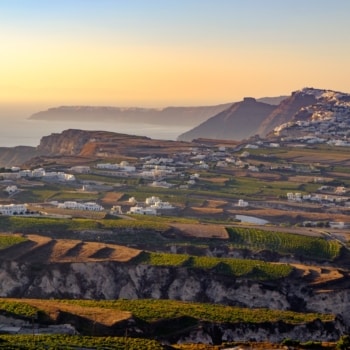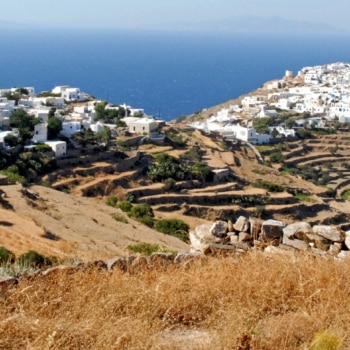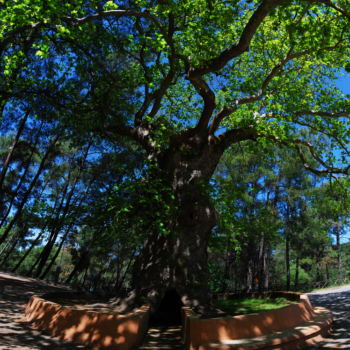For their most part the Aegean islands are small and do not have zones with big differences in the altitude. Thus the vegetation that is formed on these islands is usually the Brushwood and Maquis (low vegetation) and limited forests of Brutia Pine. Generally, the Aegean flora consists of species that can endure the arid conditions of the Mediterranean summer and the water shortage. Typical species of brushwood vegetation are the rock roses Cistus spp., the aestiva species and various species of aromatic plants such as the sage Salvia spp. and the thyme Thymus spp. Typical species of Maquis vegetation on the Aegean islands is the yew tree Quercus coccifera, the pistacia Pistacia lentiscus, the carob tree Ceratonia siliqua, Olea sylvestris, the forests of Pinus brutia, the cypress Cupressus spp. And the oak Querqus spp. One of the most typical trees in the Mediterranean is the Oil tree Olea europaea, which is either in a wild state or as a cultivated tree and it is closely connected to the Aegean and its civilization’s history. It is considered to be the oldest and the most important cultivated plant of the area.
With particular regard to the Cyclades, rare species of plants grow on the mountains and hills of Sikinos such as: Symphytum cycladense, Brassica cretica, Seseli crithmifolium, Campanula laciniata, Campanula heterophyla, Senecio bicolor, Rhamnus alaternus. Naxos is characterized by sand dunes with rare clusters of Cedars and Thira or Santorini is covered by low Brushwood. On many islands of the Dodecanese complex there are endemic and rare plant species such as in Megisti, Saria, Karpathos, Kos and Rhodes.
Kos has been called “Garden of the Aegean” due to the thick vegetation which is ensured by the abundant waters of the island. On this island, where the Plane tree of Hippocrates is located, unique Monument of Nature, someone can still find native forests of orizontalis and perennial cypress trees of the species Cupressus sempervirens var. orizontalis. The forest in Rhodes has been declared as a Monument of Nature. In Rhodes the carob tree grows, which is found in poor soils and the Brutia pine which is extremely resistant to draught, cold and winds. In the hotter and more arid areas of the Aegean there are also Arbutus unedo, Pistacia and other xenophilous bushes. In addition, although in small clusters, the palm tree of Theofrastos Phoenix theophrastii, which is endemic in East Mediterranean, is found in the Dodecanese (Karpathos, Halki, Nisyros).
The coasts constitute very important ecosystems as well. Sometimes they are sandy where particular conditions of salinity, temperature and humidity prevail, and there are mainly bushes or grasses Salicornia europaea, Suaeda maritima, Salsola soda, Spergularia marina, Aster tripolium, Polypogon monspeliensis, Limonium sp., Hordeum marinum, Atriplex hastata, Eryngium maritimum, Cynodon dactylon etc. and often lots of other rare and endemic species are found adapting to these conditions. Other times the coasts are rocky and the rocks rise many meters above the sea. The lack of soil, the increased salinity and the isolation create particular conditions for plants and animals. The numerous rocky islets belong to this category as well. In these areas we can find the chasmophytes which grow on the rock crevices where little soil is withheld. Finally, of great ecological importance are the habitats of the coastal sand dunes with cedar or juniper trees (Juniperus drupacea).
Furthermore, the large degree of endemic flora that the Aegean shows is quite impressive (see relative section).
Finally, the rural landscapes, which have been created after many years of interaction between man and natural environment, are typical habitats of the Aegean with great ecological value.
Sources:
Liarikos, Κ., Marangou, P., & Papagiannis Th. (Publication supervisors) 2012. Greece now and then: Longitudinal mapping of land cover, 1987-2007. WWF Hellas, Athens.
http://www.greenapple.gr/articlesdesc.php?id=219
http://www2.egeonet.gr/Forms/fLemmaBody.aspx?lemmaid=6947#chapter_4
Relative articles:
http://www.tovima.gr/science/article/?aid=413976
Endemic Flora
Regarding the endemic flora of the South Aegean islands both the origin of these islands and the way and time of their formation constituted the background for the development of the extremely rich in biodiversity local flora, which includes 1.400 species in the Cyclades, 83 out of which are endemic, and about 2.200 species of East Aegean including the Dodecanese, 86 out of which are endemic. In Rhodes, on the limestone rocks of mountain Attavyros we meet the impressive Centaurea lactucifolia as well as the rare Asyneuma giganteum that blooms once a year, which is also an endangered species because the area of its expansion is small (Rhodes, Halki, Karpathos), its populations are small and the grazing deteriorates it on the very steep and inaccessible rocks. Furthermore, the genus Allium (garlic species) is represented by a large number of endemic species in the area of the Aegean. Allium brulloi and Allium luteolum are included in the ancient species. The former is stenoendemic and found only on rock crevices in Astypalea. The latter though has a wider expansion on brushwood and rocky terrains in many islands: Amorgos, Anafi, Anydros, Koufonisia, Naxos and Paros. Many neoendemic species are found on the Aegean islands, species which have been differentiated relatively recently and they occupy quite small areas since they did not have the time to expand. In the neoendemic species of the South Aegean area we find Nigella arvensis aristata, Nigella carpatha (Kassos, Karpathos) and Nigella doerfleri (Antikythira, Velopoula, Cyclades and Crete). The Aegean islands of different size, altitude and origin and especially the rocks and the large complexes of limestone rocks –result of the complex geological history of the islands- such as Kalamos of Anafi and Krikelas of Amorgos, offer a variety of habitats that favor the differentiation and the creation of endemic plant species.
The easily accessible gorge in Palatia of Saria constitutes a characteristic example with more than 20 endemic and rare chasmophytes, such as the bushes of Hirtellina fruticosa (common in Astypalea, Karpathos, Kasos, Crete, Symi) the huge Seseli gummiferum subsp crithmifolium (cilantro type, rare in South Aegean) and Dianthus fruticosus subsp carpathus (the bushy wild carnation of Karpathos) that are found sporadically. A typical example of neoendemism is the Campanula species (bellflower) which are represented by 30 Greek endemic taxa in the Aegean. Some of them are restricted in one island, such as Campanula carpatha which is found everywhere in Karpathos as long as there are rocks. Others are found in many islands, though in a small percentage in each one, such as Campanula laciniata, known as ‘moustamamvla’ in Folegandros. Other endemic bellflowers are Campanula pinatzii (Karpathos, Kassos) and Campanula rhodensis (Rhodes).
Additionally, the rare and endangered peony of Rhodes, Paeonia clusii subsp. rhodia or ‘flaskanoura’ for the locals, grows in the cypress forests and only there. The white, spring cyclamen of Rhodes is common in forests and shrublands in Rhodes and Kos.
Finally, the endemic species which thrive on the rocky islets of the Aegean are quite interesting. They are usually located in the special coastal zone where there is sea spraying. Silene holzmannii has been found in 34 islets. It grows in halophytic meadows, which are shared with the daisy of the islets, Anthemis scopulorum, on the islets of Mikro Kalapodi, Dio Adelfia of Folegandros, Tristomo of Karpathos and Megalo Fokionisi.
Source:
Delipetrou P. & Georgiou Κ. 2010. “Aigeo: Mia thalassa zois. Endimismos kai endimika fyta. I Fisi”: volume 129, pages 16-20. Hellenic Society for the Protection of Nature.









